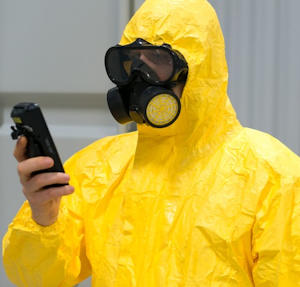06.F.05 Radiation Monitoring, Surveys, and Dosimetry.
- Users of radioactive material or radiation generating devices must conduct surveys and monitoring to ensure occupational dose limits are not exceeded.

Conduct surveys and monitoring to ensure occupational dose limits are not exceeded.
- Instruments used for radiation monitoring and surveying must be:
- (1) Available and used whenever radioactive material or radiation generating devices are used;
- (2) Properly calibrated at least annually to a National Institute of Standards and Technology (NIST) traceable source;
- (3) Appropriate for the type and intensity of the radiation surveyed;
- (4) Operationally checked against a dedicated check source before each use; and
- (5) The RSO must maintain at least two survey instruments to accommodate maintenance and calibration downtime.
- Users of radioactive material or radiation generating devices and visitors or personnel performing work tasks in the area must coordinate with the RSO for appropriate dosimetry use whenever any of the following situations exist:
- (1) An individual enters a Radiation Area (> 5 mrem [50 microsieverts (uSv)] in any one (1) hour at 1 ft (30 cm) from the radiation source), or a High Radiation Area (> 100 mrem [1 mSv] in any one (1) hour at 1 ft (30 cm) from the radiation source), or a Very High Radiation Area (>500 rad [5 Gray (Gy)] in 1 hour at 3.3 ft (1 m) from the radiation source);
- (2) An individual has the potential to receive greater than the ALARA limits established pursuant to Section 06.F.04.a.(3) in 1 year.
- All external dosimetry must be processed by a National Voluntary Laboratory Accreditation Program (NVLAP) certified laboratory. USACE personnel must use dosimetry provided by the Army Dosimetry Center.
- Users of unsealed radioactive material sources must institute an internal dosimetry program:
- (1) When there is a potential for an employee to receive an internal dose of greater than 0.5 rem (5 mSv) per year;
- (2) That is reviewed and approved by a qualified health physicist, and
- (3) That contains provisions for a pre-exposure bioassay, a bioassay method capable of detecting internal radioactive materials, at a level below 10% of the annual limits of intake (ALI) listed in Appendix B of 10 CFR 20 for each radionuclide used, appropriate action levels for requiring additional bioassay, actions for individuals found to have internally deposited radioactive materials, and provisions for post-exposure bioassay.
06.F.06 Access, Storage, and Control.
- All radiological devices and radioactive materials must be designed, constructed, installed, used, stored, transported, and disposed of in such a manner to ensure personnel exposures are kept ALARA.
- Users of radioactive materials or radiation generating devices must post signs and control access to radiation areas in accordance with Section 06.F.08.
- Where radiation levels exceed 2 mrem (20 uSv) in any 1 hour period, users must use engineering controls, shielding, access time limitation, and/or physical separation to keep doses to the public ALARA.
- Users must secure radioactive material and radiation generating devices against theft or unauthorized use.
- Storage must be in accordance with any license or permit requirements.
- Radioactive material and radiation generating devices, not in storage, must be under constant control and surveillance.
- Operations involving regulated radiation hazards or users of regulated radioactive material or radiation generating devices must conduct surveys to ensure that the public dose limit of 0.01 rem (0.0001 Sv) is not exceeded.
06.F.07 Respiratory Protection and other Controls.
- Users of radioactive material must, to the extent practicable, institute process or engineering controls to limit concentrations of radioactive materials in air.
- Where process or engineering controls are unable to control airborne radioactive material concentrations, users must increase monitoring and limit intakes of radioactive materials through control of access, limitation of exposure times, use of respiratory protection equipment, or other controls.
- The use of respiratory protection equipment must be in compliance with Section 05.G of this manual, and must be limited by the protection factors listed in Appendix A of 10 CFR 20.
Knowledge Check Choose the best answer for the question.
6-11. Which of the following controls is to be considered first, to the extent practicable, to limit concentrations of radioactive materials in air.
You forgot to answer the question!
